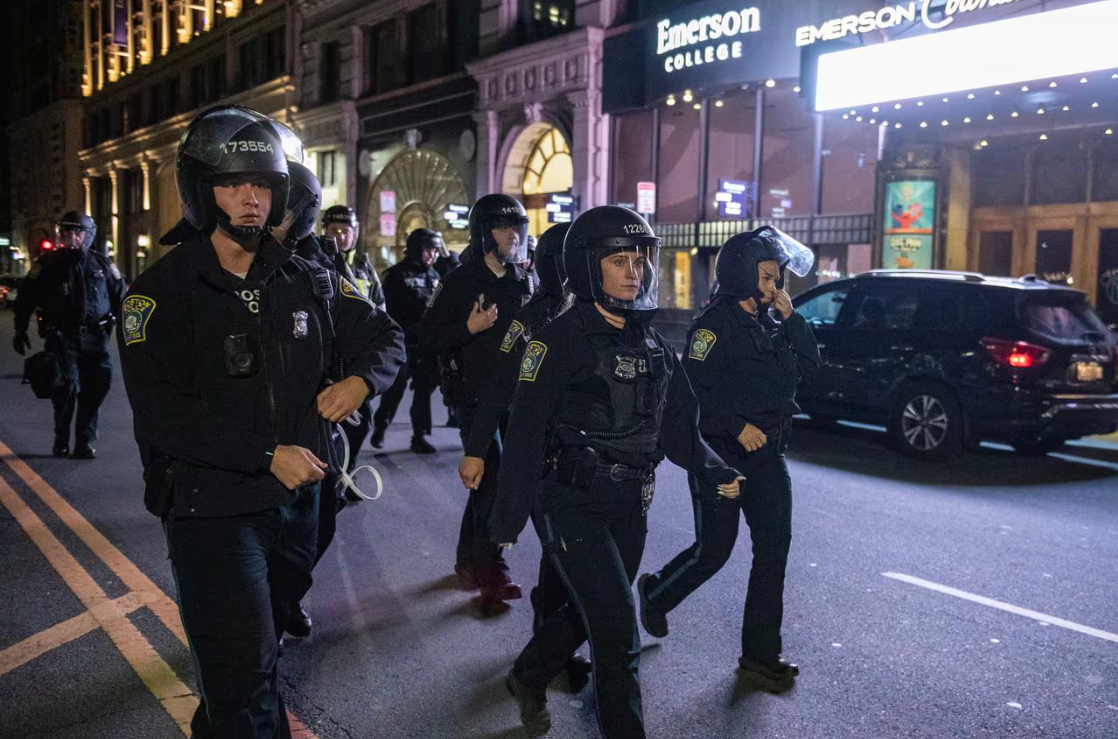在艾默生学院附近发生大规模逮捕事件后,吴弭市长支持波士顿警方

【中美创新时报2024 年 4 月 25 日编译讯】(记者温友平编译)波士顿市长吴弭为波士顿警方对爱默生学院附近亲巴勒斯坦示威活动的处理方式进行了辩护,该示威活动于周四凌晨导致大规模逮捕和破坏帐篷营地,但其他城市政界人士和一些支持者批评这一行动过于严厉。《波士顿环球报》记者Daniel Kool、Danny McDonald 和 Niki Griswold 对此作了下述详细报道。
“我们的目标始终是维护和尊重城市中安全、和平的抗议活动,”在博伊斯顿广场巷 (Boylston Place Alley) 附近有 100 多人被捕后,吴弭告诉《波士顿环球报》说。“但是,随着越来越多的公共道路受阻,安全问题也随之增加,安全风险也越来越大。”
吴弭说,市政府已与艾默生官员密切合作,“寻找一切机会安全地参与和平抗议”。
“这意味着公共通行权上不会有火灾隐患,也不会存在帐篷的健康和安全风险,”她说。但市长没有透露最终是谁做出了派遣警察的决定。
吴弭说,波士顿消防官员本周早些时候检查了示威现场,并对帐篷堵塞人行道和公共建筑门表示担忧。吴弭说,周三上午,我们向艾默生表达了这些担忧。

警察局发言人周四在一份声明中表示,那些搭建帐篷营地的人多次收到通知,称他们违反了城市规定,可能会被逮捕。
艾默生校长杰伊·伯恩哈特(Jay Bernhardt)和临时副校长兼教务长扬·罗伯茨-布雷斯林(Jan Roberts-Breslin)在一份声明中表示,“因为我们对昨晚的事件做出反应和处理”,艾默生周四取消了课程。
伯恩哈特在给校园社区的另一条消息中说:“我们正在收集有关逮捕的信息,并将在获得信息后分享这些信息。”
但学生和其他目击这场冲突的人谴责警方的反应过于严厉,而一些民权专家则建议大学在应对学生示威时应更加克制。
博斯托皮亚新闻播客主持人、美国波士顿民主社会主义者成员埃文·乔治表示,警察冲向学生,抓住并拉扯他们,现场迅速陷入混乱。
“警方的行动非常暴力,而且没有必要,”他说。
被捕者之一是 DSA 媒体“Working Mass”的视频记者丹·奥尔布赖特 (Dan Albright),他说,身穿防暴装备的警察让人想起步兵的画面,并将抗议者困在巷子里。
他说,当一名警察抓住他的手臂时,他以为自己会被护送出人群。但他被戴上手铐,在牢房里关了九个小时,并面临扰乱治安的指控。
“这真是令人震惊,”布莱顿居民奥尔布赖特说。
市议会主席鲁思泽·路易珍 (Ruthzee Louijeune) 也对警方反应的规模提出质疑,她在一份声明中表示,“我警告不要对抗议采取严厉的应对措施…… 确保选择行使抗议权利的学生得到尊严和尊重是我们的集体责任。”
这一场景让人想起2011年的“占领”运动,当时抗议者在美国各地的公共场所举行露营活动,呼吁人们关注财富不平等。波士顿的抗议活动最终导致 100 多名示威者被捕,其中许多人同样在社交媒体上分享了自己的账户。
马萨诸塞州美国公民自由联盟执行主任卡罗尔·罗斯表示,需要更多有关事件顺序的信息才能确定警方的反应。
“事实上,人们是否得到了足够的通知?事实上,人们是否有机会离开而不是被捕?” 罗斯在接受采访时说道。“存在法律问题:人们的公民权利是否受到侵犯?然后是公共政策问题,我们真的可以通过逮捕来和平解决问题吗?”
据支持者和抗议者称,艾默生被捕之前,学生们自周日晚上以来一直在市中心的小巷里露营,并发誓要留在原地,直到学院满足他们的要求,其中包括呼吁加沙停火,以及要求艾默生放弃其可能拥有的任何与以色列的经济联系。这是继上周哥伦比亚大学 100 多人被捕后,全国各地校园中涌现出的数十个此类事件之一。许多其他校园抗议活动也被警察驱散,许多学生被捕。
社交媒体上的视频显示,德克萨斯大学奥斯汀分校的警察猛烈拘留了数十人,其中包括福克斯七号奥斯汀频道的一名摄影师,警方显然将其扔在了地上。在亚特兰大埃默里大学,当地电视新闻台播放的一段视频显示,警方对一名被按在地上的人使用了泰瑟枪。
前波士顿市议员、众议员阿亚娜·普莱斯利 (Ayanna Pressley) 在周四的一份声明中表示,她对学生抗议活动的反应“深感担忧”,包括“执法部门对全国各地和平抗议的学生的积极反应”,尽管她表示没有具体引用艾默生事件。“不应召集国民警卫队或防暴警察来回应学生的和平言论自由。我要明确的是:我们绝对不应该重蹈前人的覆辙,历史会注视着我们。”
在波士顿,警方周四发布的警察与抗议者之间对抗的录像显示,警察队长肖恩·P·马丁(Sean P. Martin)向小巷附近的人群讲话,多次告诉抗议者,“我不想逮捕任何人” ”。
“我们不希望任何人受伤,”他补充道。
在其他随身摄像机的镜头中,一名波士顿警官引用了一项禁止在公共财产上搭帐篷的城市法令,该法令是为了在阿片类药物和无家可归危机的中心(即马萨诸塞大道和卡斯大道)拆除帐篷而制定的。
“我知道世界性事件、全球性事件对我们的社区来说是极其痛苦和激动的,但我们不能让这破坏波士顿居民的安全和福祉,”吴弭说。“该市制定的公共安全法律在全市范围内执行,而不仅仅是在马萨诸塞大道和卡斯这样的地区,每当出现火灾隐患时,该市都必须采取行动。”
穆斯林正义联盟执行董事法特玛·艾哈迈德(Fatema Ahmad)参加了艾默生抗议活动,并表示警方的反应“凸显了该法令从一开始就是不公正的”,并补充说它将无家可归者定为犯罪。
波士顿公共安全顾问克里斯汀·科尔表示,涉及言论自由和公共安全的冲突往往是困难而微妙的。
她说:“在这种情况下,将人员驱离既是非大学财产的入口又是出口的区域似乎是一项重要的公共安全应对措施。”
她说,如果警察清楚他们在做什么以及为什么这样做,并给人们驱散的机会,“这感觉很重要。”
占领波士顿期间担任波士顿警察局长的埃德·戴维斯(Ed Davis)将该运动与当前的抗议活动进行了一些相似之处。
戴维斯说:“接管,建立一个营地,让自己出名。”他强调,占领运动的目标与目前的亲巴勒斯坦集会不同。
戴维斯认为波士顿警察局长迈克尔·考克斯在艾默生示威中“做了他必须做的事”。
戴维斯说:“你不想显得很严厉,但当人们做违法的事情时,就必须受到处理。”
个人权利与表达基金会的律师兼联合创始人哈维·西尔弗格拉特表示,学生“有权在一定限度内”在大学校园内示威。
“你可以相当大声,但不要大声到干扰课堂或图书馆里的人。你无法阻止人们进出,但你当然可以让人们知道你的存在,”西尔弗盖特说。
他补充说,艾默生营地位于市政府部分拥有的一条小巷上,这赋予示威者比仅在私人财产上“更大”的抗议权利。
“很多大学校长和院长没有研究过宪法文本,所以他们不知道自己的适当限制是什么,”他说。 “因此,只要校园的安静、良好秩序受到威胁,他们就倾向于报警。”
本报告使用了美联社的材料。 《环球报》记者艾娃·伯杰对此报道做出了贡献。
题图:4 月 25 日,警方部署清理波士顿艾默生学院的亲巴勒斯坦抗议营地。JOSEPH PREZIOSO/AFP VIA GETTY IMAGES
附原英文报道:
Mayor Wu backs Boston police in wake of mass arrests near Emerson College
By Daniel Kool, Danny McDonald and Niki Griswold Globe Correspondent and Globe Staff,Updated April 25, 2024
Mayor Michelle Wu defended Boston police’s handling of a pro-Palestinian demonstration near Emerson College that culminated early Thursday morning with mass arrests and the breakup of a tent encampment, but other city politicians and some advocates criticized the action as unnecessarily harsh.
“The goal was always to uphold and respect, safe, peaceful protests in the city,” Wu told the Globe after the arrests of more than 100 people near Boylston Place Alley, a short walkway opposite Boston Common that provides pedestrian access to the state transportation building. “But there were safety concerns and the safety risks were growing as more and more obstruction of the public way took place.”
Wu said city authorities had worked closely with Emerson officials to “find every opportunity to participate in peaceful protest safely.”
“That means not having fire hazards and not having the health and safety risks of tents in the public right of way,” she said. But the mayor did not say who ultimately made the decision to send in police.
Boston fire officials inspected the site of the demonstration earlier this week, according to Wu, and conveyed concerns about the tents blocking the walkway and doors to public buildings. Those concerns were shared with Emerson Wednesday morning, Wu said.
A Police Department spokesperson said in a statement Thursday that those who had set up the tent encampment were notified multiple times that they were violating city rules and could be subject to arrest.
Emerson canceled classes Thursday “as we respond to, and process, the events of last night,” president Jay Bernhardt and interim vice president and provost Jan Roberts-Breslin said in a statement.
”We are gathering information about the arrests and will share this information as it becomes available,” Bernhardt said in a separate message to the campus community.
But the police response was denounced as heavy-handed by students and others who witnessed the confrontation, while some civil rights experts suggested colleges should use more restraint addressing student demonstrations.
Evan George, host of a podcast called Bostopia News and a member of Boston Democratic Socialists of America, said police rushed the students, grabbing and pulling them in a scene that quickly devolved into chaos.
“The police action was incredibly violent and unnecessary,” he said.
Dan Albright, a video journalist for the DSA outlet Working Mass who was among those arrested, said police officers clad in riot gear evoked images of an infantry, and had the protesters boxed in in the alley.
He said that when an officer grabbed him by the arm, he thought he was going to be escorted out of the crowd. But he was cuffed and spent nine hours in a jail cell, and faces a disorderly conduct charge.
“It was quite appalling,” said Albright, a Brighton resident.
City Council President Ruthzee Louijeune also questioned the scale of the police response, saying in a statement, “I caution against heavy-handed responses to protest. . . . It is our collective responsibility to ensure that students who choose to exercise their right to protest are met with dignity and respect.”
The scene was reminiscent of the Occupy movement in 2011 when protesters calling attention to wealth inequity staged encampments in public spaces around the United States. The protest in Boston eventually resulted in the arrests of more than 100 demonstrators, many of whom similarly shared their accounts on social media.
Carol Rose, executive director of the ACLU of Massachusetts, said more information about the order of events is necessary to make a determination about the police response.
“Were, in fact, people given sufficient notice? Were people, in fact, given an opportunity to leave rather than be arrested?” Rose said in an interview. “There are the legal questions: were people’s civil rights violated? And then there are the public policy questions, which [are], can we actually arrest our way to a peaceful resolution?”
The Emerson arrests came after students had camped out in the downtown alleyway since Sunday evening, vowing to stay put until the college met their demands, which include calling for a cease-fire in Gaza, and for Emerson to divest any financial ties it may have with Israel, according to advocates and protesters. It was one of dozens on campuses across the country that sprouted after the arrests of more than100 at Columbia University last week. Many of the other campus protests were also broken up by police, with numbers of students arrested.
Videos on social media showed officers at the University of Texas at Austin aggressively detaining dozens, including a photographer for Fox 7 Austin who police apparently threw to the ground. At Emory University in Atlanta, a video broadcast by a local television news station shows police deploying a taser on a person who is pinned to the ground.
Representative Ayanna Pressley, a former Boston city councilor, said in a statement Thursday that she was “deeply concerned” about how the student protests were being received, including “the aggressive response by law enforcement to students peacefully protesting across the country,” though she did not specifically cite the Emerson incident. “The National Guard or riot police should not be called in response to students’ peaceful freedom of expression. Let me be clear: we absolutely should not repeat the mistakes of generations past, and history has its eyes on us.”
In Boston, police body camera footage of the build-up to the confrontation between police and protesters released Thursday showed police Captain Sean P. Martin addressing the crowd near the alleyway, telling the protesters multiple times, “I don’t want to arrest anyone.”
“We don’t want anyone to get hurt,” he added.
In other body camera footage, a Boston police sergeant cited a city ordinance prohibiting tent encampments on public property that was adopted to break up tents at the epicenter of the opioid and homelessness crises, an area known as Mass. and Cass.
“I know that world events, global events are incredibly painful and emotional for our community, [but] we cannot let that destabilize the safety and well-being of our residents here in Boston,” said Wu. “The laws that the city has on the books for public safety are enforced citywide and and not just in an area like Mass. and Cass, and whenever there’s a situation where there are fire hazards, the city has to take action.”
Fatema Ahmad, executive director of the Muslim Justice League, was at the Emerson protest and said the police response “highlights how that ordinance is unjust to begin with,” adding it criminalizes people who are homeless.
Christine Cole, a Boston-based public safety consultant, said conflicts involving both free expression and public safety tend to be difficult and delicate.
“In this case, it seems that removal of people in an area that is both an entrance and an egress to non-college property seems an important public safety response,” she said.
If police were clear about what they were doing and why and gave people the opportunity to disperse, she said, “that feels important.”
Ed Davis, who was Boston police commissioner during Occupy Boston, drew some parallels between that movement and the current protests.
“Take over, build a camp, and make yourself known,” said Davis, who emphasized that Occupy was grounded in different aims than the current pro-Palestine rallies.
Davis thought Boston police commissioner Michael Cox “did what he had to” at the Emerson demonstration.
“You don’t want to appear to be heavy-handed, but when people are doing things that violate the law, it has to be dealt with,” said Davis.
Harvey Silverglate, an attorney and cofounder of the Foundation for Individual Rights and Expression, said students “are entitled to demonstrate” on college campuses, within certain limits.
“You can be reasonably loud, but not so loud as to interfere with classes going on or people in the library. You cannot block people from coming in and out, but you can certainly make your presence known,” Silverglate said.
He added that the location of the the Emerson encampment on an alleyway partially owned by the city gave the demonstrators “even greater” right to protest than if they were only on private property.
“So many college presidents and deans haven’t studied their constitutional law text, so they have no idea what their proper limitations are,” he said. “So they are inclined to call the police anytime the quiet, the good order of their campuses is threatened.”
Material from the Associated Press was used in this report. Globe correspondent Ava Berger contributed to this report.

